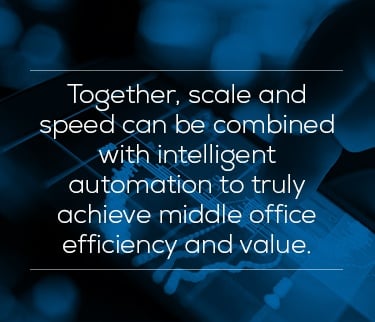Why the cloud is the answer to true ‘any analytics’ scalability.

Growing pains
Growth in both data volumes for performance measurement calculations and complexity with risk calculations presents a double-header challenge for the middle office.
Not only do they have more granular data to process in the first place, but also the complexity of those calculations has increased exponentially. They need to do more, on a bigger and more complex scale, and faster than ever before.
In simple terms this means scalability and speed. If a system is bursting at the seams and cannot store more data or meet a demand for greater complexity at a given point in time, it is essentially unfit for purpose. Today’s systems need to accommodate large volumes of historical data and have the ability to crunch complex calculations, without needing huge overnight calculation windows.
A platform that provides this is the dream team of scale and speed.
Status: it’s complicated
Aside from the sheer volume of tasks requested, the complexities in the data provide a significant challenge. The more facets to the data and the more complicated the calculation, the more potential there is for something to go wrong.
A slight error with just one of the many different components and variables can result in errors in final reports or bring the whole process to a shuddering halt. In this sense, the scalability factor is not just what the system can do, it is more about the way that it does it: making sure that the end product is accurate and available to all downstream users with an ever-shorter window of time to play with.
A sign of the times
The scaling and the speed required to accommodate today’s demands was unimagined when many of the current systems were installed, let alone when they were designed.
As a result, existing server-based systems are just not able to scale on this level. Nor are they able to cope with complex calculations. And they certainly can’t perform within the timeframe that is demanded today. Their underlying software architecture limitations have reached a natural end. They have snapped in the face of the demand for elasticity.
The other issue with outmoded systems is that time pressures eventually become a self-fulfilling prophecy; errors start to occur. Once that happens it takes longer to identify the source in the first place. Then everything has to be stopped while the error is fixed and then calculations restarted, sometimes right from the beginning. This means that not only is the calculation with the error impacted, but also any other calculations that are reliant on that initial calculation. It becomes a domino effect and the risk is that the whole overnight process grinds to a halt.
Once that happens, the knock-on effect is felt right down the line and extends along the value chain, especially at month end.
The moon on a stick
We live in a world where stakeholder demand and expectations are on the increase. They also want results in a specific format, from various angles, and in great volumes. Faced with such unprecedented demand, a system that slows down delivery is just not viable.
Happily, cloud-based platforms are ideally placed to solve these issues. New applications have been designed to scale across hundreds of servers if needed, which gives extra resources whenever required. This is one of the inherent attractions of the cloud. To be able to upscale on demand and dictate the speed of the process is massively attractive to the middle office. Computing demand isn’t always at 100%, but when it is, it is needed quickly and this is the beauty of elastic cloud computing.
Conclusion: The perfect match
Together, scale and speed can be combined with intelligent automation to truly achieve middle office efficiency and value. Something that might have previously taken days and required careful monitoring is now reduced to a matter of hours and can run without any manual input. This means that the daily workflow is simplified and streamlined – leaving the middle office time to add value elsewhere.
In a way, the middle office is simply passing on the high-volume, high-complex work requests that it itself is receiving. With reduced turnaround times but evermore complex calculations in ever-growing volumes, the middle office needs a platform it can rely on. Middle office output needs to be right first time, with valuable, actionable information generated for all stakeholders, both within the firm and externally to clients.
The cloud also presents an efficiency in terms of cost. Because it can up and downscale as and when required, the firm is not paying for capacity that is just sitting unused when not needed. This represents a win-win situation for fund managers who want to respond to fee pressure with lower operational costs. Add that to its inherent capabilities when it comes to scale, speed, and standardization through intelligent automation, and the move to the cloud becomes an increasingly compelling proposition.
Key takeaways
- The scaling and the speed required to accommodate today’s demands was unimagined when many of the current systems were put into place, which makes them unfit for purpose.
- Systems need to do more, on a bigger scale, and more quickly than ever before.
- The end product needs to be accurate and available to all downstream users as and when they need it.
- New applications in the cloud can be designed to scale across hundreds of servers if needed.
- Together, scale and speed can be combined with intelligent automation to operate at maximum efficiency.
Discover what the future has in store for the middle office: download our complimentary eGuide, How can we automate and scale the middle office?
{{cta(‘d18596d6-0dd0-4ebc-be8c-391bd00cd49a’)}}